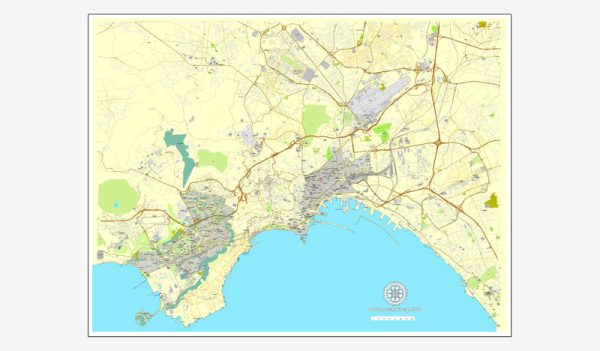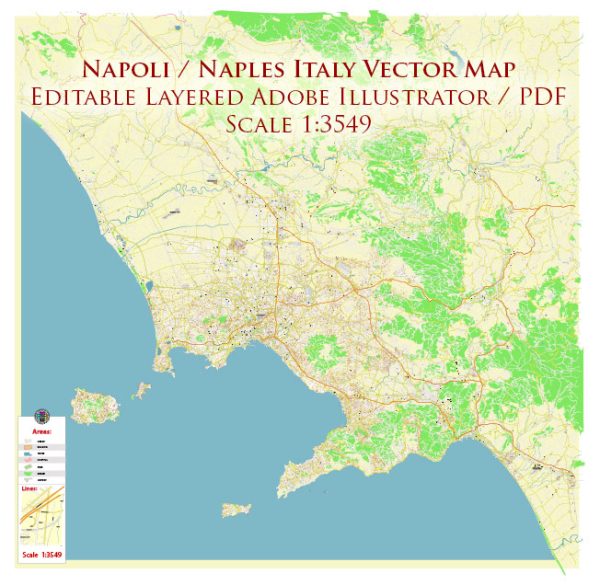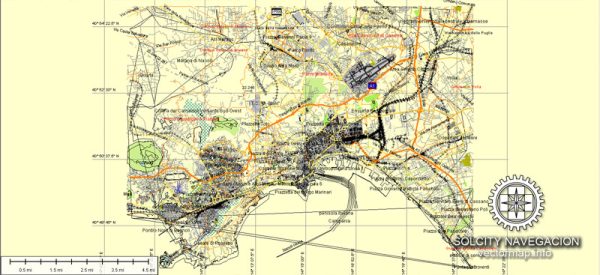Naples, a historic city in southern Italy, has a rich and diverse history, a bustling port, and a well-developed transportation infrastructure.
Vectormap.Net provide you with the most accurate and up-to-date vector maps in Adobe Illustrator, PDF and other formats, designed for editing and printing. Please read the vector map descriptions carefully.
History:
- Ancient Origins: Naples, or Neapolis in ancient Greek, was founded by Greek settlers in the 8th century BC. It played a significant role in Magna Graecia, the Greek colonies in southern Italy. Over the centuries, it came under Roman rule and flourished as a major cultural and economic center.
- Roman Period: Naples became an important Roman city, with notable structures like the Castel dell’Ovo and the Catacombs of San Gennaro. It thrived as a trading hub and was known for its luxurious villas.
- Medieval and Renaissance Periods: The city faced various invasions and changes of rulers, including Norman and Spanish influences. Naples was part of the Kingdom of Naples and later the Kingdom of Two Sicilies. During the Renaissance, the city experienced a cultural revival.
- Unification of Italy: Naples played a role in the unification of Italy in the 19th century. Garibaldi and his troops entered Naples in 1860, contributing to the establishment of the Kingdom of Italy.
- World War II: Naples suffered significant damage during World War II, but it was rebuilt in the post-war period. The city went through a process of modernization and economic development.
Port:
Naples has one of the most important and busiest ports in the Mediterranean.
- Port of Naples: The Port of Naples, also known as Porto di Napoli, is a major seaport that handles both passenger and cargo traffic. It is strategically located, making it a key hub for maritime trade in the region.
- Functions:
- Passenger Terminal: The port serves as a gateway for ferries and cruise ships, connecting Naples to various Mediterranean destinations.
- Cargo Handling: It facilitates the import and export of goods, serving as a crucial economic lifeline for the city and the surrounding region.
- Infrastructure:
- The port is equipped with modern facilities, including container terminals, warehouses, and transportation links.
- Passenger terminals cater to the needs of tourists arriving by sea.
Transportation Infrastructure:
Naples has a well-developed transportation network that includes various modes of transport.
- Public Transportation:
- Metro: Naples has an efficient metro system with three lines connecting different parts of the city.
- Buses and Trams: An extensive network of buses and trams serves the city and its suburbs.
- Rail Transportation:
- Naples is a major railway hub, with high-speed trains connecting it to other Italian cities.
- The central railway station, Napoli Centrale, is a key transportation hub.
- Road Network:
- Naples is connected to the Italian motorway system, facilitating road transport within the city and to other regions.
- Airports:
- Capodichino Airport (Aeroporto di Napoli-Capodichino) serves as the main international airport, connecting Naples to various destinations.
In summary, Naples boasts a rich history, a bustling port handling both passengers and cargo, and a well-developed transportation infrastructure that includes a modern metro system, extensive bus and tram networks, a central railway station, and an international airport.




 Author: Kirill Shrayber, Ph.D.
Author: Kirill Shrayber, Ph.D.